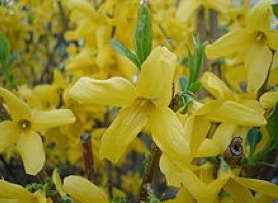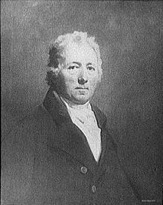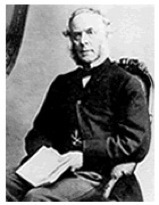Foraging For Forsythia
If you study the eating habits of North American Indians you learn one thing quite quickly. They weren’t mono-green eaters. What I mean is, they usually didn’t eat just one green species of plant at a time.
Today when we have a meal we often have one green food, say string beans or spinach. That serving comprises the entire green portion of the meal. The Indians simply did not do that. It was a leaf here, a blade there, a shoot from over yonder, all mixed in together. From such meager foraging a meal is made. And while the Forsythia was not on their menu it’s one of those little edible you usually mix in with other things.
For a very common ornamental that has also liberated itself there is nothing about the Forsythia as an edible plant in my entire library, which is now around 100 books plus papers, DVDs et cetera. Yet the blossoms are edible raw, though they can be slightly bitter. They add color to salads and are a cheery garnish. The very young leaves are also edible raw but that’s iffy as they contain some of the glycoside Phillyrin, and it’s debatable just how nasty that is. Very young leaves have also been added to soups. As you can see the key is “very young leaves.” I suspect we know these things because some folks in were very hungry for anything green in the spring after long winters.
The Forsythia genus is named for the Scottish botanist William Forsyth. He was the royal head gardener and a founding member of the Royal Horticultural Society. He is also credited with (intentionally) building the first English rock garden. As a bit of genealogical history the British entertainer Bruce Forsyth is a descendant of his.
As a native to China the Forsythia was introduced to the rest of the world by fellow scotsman Robert Fortune, below, a famous/infamous plant hunter. It was Fortune who single-handedly smuggle the plants and know-how to make tea out of China establishing it in India, a bit of botanical espionage from which China has only recently recovered. After 250 years China now leads India in tea production. Fortune, who did not know much Chinese or botany did so disguised as a Chinese peasant. And now you know why the British drink tea. They had wars with China but India was their colony. So they planted tea in a friendly place, or occupied place. Views vary.
There are about a dozen species of Forsythia, depending upon who’s counting and if you include at least one hybrid. Most of them are native to eastern Asia but one is native to southeastern Europe. There are also many cultivars including dwarf and compact forms. F. suspensa, the weeping Forsythia, is an important herb in Chinese medicine and has been used for at least three thousand years, perhaps four. Called lian qiao it’s unripe yellow fruit and seeds are ground together. Lian qiao is used internally for chills, fevers, headaches and externally for burns, infections, rashes and the like. Lab tests show the seed to be anti-inflammatory (Rouf et ali 2001 and an anti-oxidant (Schinella et ali 2002.) But a 1991 study of 102 raw pharmaceuticals used in traditional Chinese medicine (Yin X et ali) suggested lian qiao might be potentially cancer causing, perhaps that glycoside issue again. In 2009 (Wang F.N., et ali) found three new glycosides in the F. suspensa bringing the total to nine. Forsythia extracts are used in commercial products treating dandruff, acne, and athlete’s foot … Sticking with just the blossoms in a seasonal salad seems wise.
Like the Eastern Redbud (pink) and the Chickasaw plum (white) the Forsythia blossoms on naked branches before its leaves appear, giving us a seasonal flame of yellow. Each of those species use the massive show of color (and ultraviolet markings) to attract early pollinators. Forsythias are found in most urban areas but they have also escaped cultivation making them quite easy to find in spring. Just look for yellow flowers and no leaves.
Oddly, or perhaps understandably, gardeners have a love/hate relationship with the Forsythia. For two weeks every year it is the darling wherever it grows. Then it is rather boring for 50 weeks. But that doesn’t deter some people. There is a Forsythia festival every year… the second week in March… in… Forsyth, Georgia, about one hour south of Atlanta. If the weather is bad the festival goes on anyway. Forsythias wait for no one. (And yes, there is a Miss Forsythia pageant.)
Green Deane’s “Itemized” Plant Profile
IDENTIFICATION: Forsythias have narrow, dark green leaves with a lighter underside, in opposite pairs, the margin is serrated. There are also a large number of variegated and golden leaved varieties. Yellow flowers, four narrow petals at right angles form a short tube. One to three flowers per node.
TIME OF YEAR: Your spring
ENVIRONMENT: Sunny, well-drained soil, may need extra watering in dry spells
METHOD OF PREPARATION: Blossoms raw, or cooked but usually raw, slightly bitter. Very young small leaves raw or cooked. Exercise caution with the leaves.
HERB BLURB
Below is the abstract of a study in its entirety. Perhaps something is lost in the translation, or I am reading it wrong. But, the last sentence seems to say don’t worry about phillyrin or forsythiaside in the tissue of the dog you are about to eat because the dog eliminates them from its system quickly. (No, I am not kidding….)
Pharmacokinetics of phillyrin and forsythiaside following iv administration to Beagle dog. Li YX, Peng C, Zhang RQ, Li X, Jiang XH.
Chengdu University of Traditional Chinese Medicine, Sichuan, China.
Abstract
The objective of the present study was to firstly investigate the in vivo pharmacokinetics of phillyrin and forsythiaside in beagle dog. On I.V. administration, a rapid distribution was observed and followed by a slower elimination for phillyrin and forsythiaside. The mean t(1/2Z) was 49.99, 34.87 and 43.81 min for 0.19, 0.70 and 1.43 mg/kg of phillyrin, and 60.90, 64.30, 57.99 min for 0.62, 1.39 and 5.52 mg/kg of forsythiaside respectively. And the AUC(o-t) increased linearly from 36.51 to 160.22 microg x min/ml of phillyrin and from 50.63 to 681.08 microg x min/ml after the three dosage administrated. In the range of the dose examined, the pharmacokinetics of phillyrin and forsythiaside in beagle dog was based on first order kinetics. Although both drugs were widely distributed to various tissues in the dog, no concerns about extensive binding to tissues that may be consumed by the public should a dog be exposed to phillyrin and forsythiaside according to the rapid elimination.




